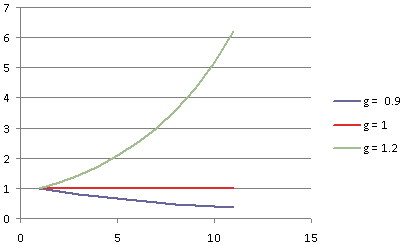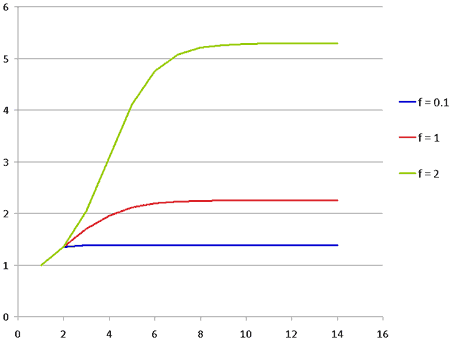Does positive feedback necessarily mean runaway warming?
What the science says...
| Select a level... |
 Basic
Basic
|
 Intermediate
Intermediate
|
 Advanced
Advanced
| ||||
| Positive feedback means that a system reacts to a stimulus by reinforcing that stimulus, so the stimulus builds up, and the output builds up, and the stimulus builds up... However, this only leads to a "runaway" instability if the reinforcement is strong enough. If it's not, as in the case with the enhanced greenhouse effect, the feedback can give rise to a definite, but stable, increase over the original stimulus. | |||||||
Positive feedback means runaway warming
"One of the oft-cited predictions of potential warming is that a doubling of atmospheric carbon dioxide levels from pre-industrial levels — from 280 to 560 parts per million — would alone cause average global temperature to increase by about 1.2 °C. Recognizing the ho-hum nature of such a temperature change, the alarmist camp moved on to hypothesize that even this slight warming will cause irreversible changes in the atmosphere that, in turn, will cause more warming. These alleged "positive feedback" cycles supposedly will build upon each other to cause runaway global warming, according to the alarmists." (Junk Science)
Note: Breaking with custom, we will discuss some math in this rebuttal, because the argument is about a mathematical topic: the implications of positive feedback. But we'll try to keep it light.
One of the problems about understanding the extent of global warming (the question of climate sensitivity) is that the total average temperature increase due to CO2 is greater than the first guess: Climatologists must also take into account "second-order" effects which add to the initial estimate of the warming. It is not easy to calculate these effects, but the general consensus is that, overall, they magnify the temperature increase by about a factor of 3. These second-order effects work as a form of "positive feedback."
An example of this: Imagine the pre-industrial world, with the Earth, land & sea, in rough thermal balance. Then add a dollop of 35% more CO2 to the atmosphere (by burning fossil fuels): Due to the enhanced greenhouse effect (EGE), the outgoing radiation of infrared energy is inhibited, and this reduction in radiative cooling raises the global average temperature. But the increase in temperature has the effect of increasing even further the amount of atmospheric CO2, because the heated ocean will hold less CO2 (think of a can of warmed Coke), and the warming Arctic tundra will reveal formerly frozen biomass that will decompose and release more CO2. So you get even more CO2 in the atmosphere, which gives rise to even more warming, which gives rise to even more CO2...
But this is where the suspicions of the skeptics are aroused: "If more CO2 gives rise to higher temperature, and higher temperature gives rise to more CO2, and this additional CO2 gives rise to even higher temperature, doesn't this go on forever? Doesn't that mean that the Earth would turn into an oven? If the greenhouse effect REALLY has positive feedback, why hasn't this happened already? Something is wrong with this picture!"
This line of thought is partly right and partly wrong:
- Yes, in a sense this cycle does go on forever; but
- No, the Earth will not turn into an oven!
How can these both be true? Well,
- The cycle does go on forever, like the reflections between two facing mirrors; but
- At each step in the cycle, the incremental increase gets smaller and smaller. After a few cycles, the increase is negligible.
When does positive feedback lead to a "runaway"?
To understand this, consider first the "classic" example of positive feedback: The output of an amplifier is plugged back into its own input. This can lead to a sustained shriek. How does it work? Starting at input level Io, the output of the amplifier is Io multiplied by the gain factor, g; this gets plugged back into the input, and comes out multiplied by another factor of g; and so on. If we plot the output as a function of the number of cycles of feedback, it looks like this:

We have used three different values for g:
- for g < 1, the output fades towards 0;
- for g = 1, the output remains unchanged; and
- for g > 1, the output grows larger and larger
So if the gain factor is > 1, and only in that case, the system is described as "runaway": Any input leads to an output that grows beyond bounds. (In the real world, the system becomes limited by factors not included in the original mathematics, so the output does not really go to infinity, but saturates at a high value. So when an audio amplifier gets into the range of runaway positive feedback, the sound system doesn't explode, it just produces an ear-shattering shriek.)
Why doesn't the enhanced greenhouse effect run away as well?
The nature of the positive feedback is different than for the case of the simple amplifier: In the case of the amplifier, the increase in output is proportional to the input; but in the case of the enhanced greenhouse effect (EGE), the increase in output is less than proportional to the input: It is logarithmic. The result is that when we plot a (highly simplified) model of the temperature increase due to the EGE against the number of feedback cycles, we get:

In these plots, we use three different values of the feedback parameter, f:
- Due to the feedback, the temperature does indeed rise beyond the initial jump (due to the dollop of 35% more CO2).
- However, after several (3 to 10) iterations, there is no further significant change.
- The terminal value of the temperature increase depends on the value of the feedback parameter f: The stronger the feedback, the larger the terminal value.
CONCLUSIONS
- When you add CO2 to this model system, there is indeed positive feedback, so even more CO2 will end up in the atmosphere than you dumped in from the burning of fossil fuels.
- However, this does not give rise to a runaway scenario: Eventually, the impact of that dollop of CO2 comes to an end.
- Now, in the real world, that end will not be an ultimate end until we stop adding more CO2 ourselves: Every time we add another dollop of CO2 through the burning of fossil fuels, we kick off another round of significant feedback cycles. Currently, we are still adding small dollops all the time...
Note: A more detailed explanation is provided here.
Last updated on 20 October 2010 by nealjking.































 Arguments
Arguments































Climate Myth...